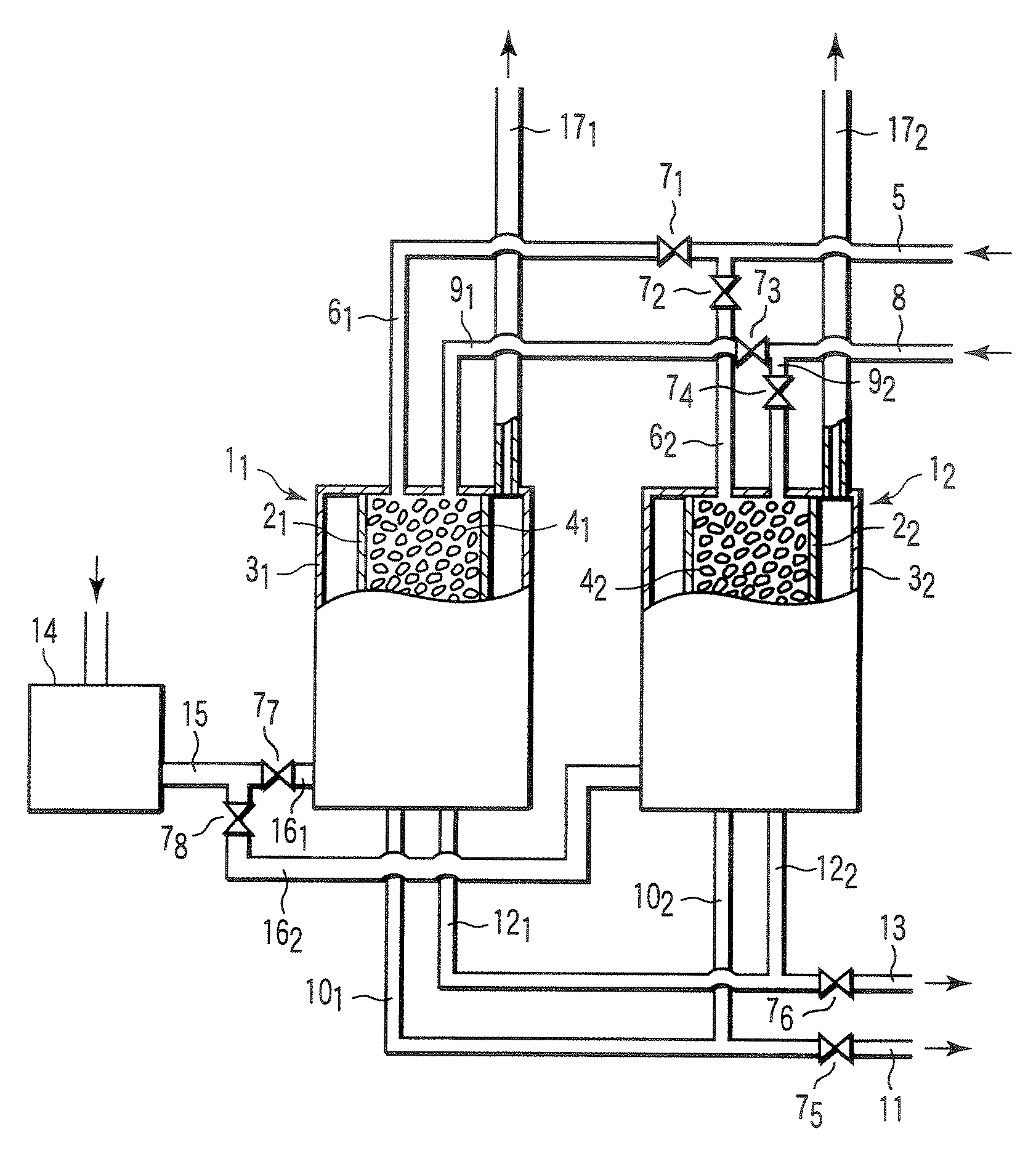Carbon dioxide absorbent, carbon dioxide separating apparatus, and reformer
a carbon dioxide and absorbent technology, applied in the direction of separation process, silicon compounds, other chemical processes, etc., can solve the problems of difficult to remove carbon dioxide from the reaction field by a conventional method, reduce the upper limit of the temperature of an introducing gas, and reduce the absorption rate of carbon dioxid
- Summary
- Abstract
- Description
- Claims
- Application Information
AI Technical Summary
Problems solved by technology
Method used
Image
Examples
example 1
[0075]A silicon dioxide powder having 0.8 μm average particle diameter and a lithium carbonate powder having 1 μm average particle diameter were prepared in such an amount in which lithium carbonate:silicon dioxide is 2.38:1 in weight ratio, and they were dry blended by using an agate mortar. Subsequently, the raw material mixed powder was processed at 1000° C. for 8 hours in the atmosphere by means of a box type electric furnace to obtain a powder principally containing lithium orthosilicate. The powder obtained was 165.1:8.98 in a weight ratio of lithium orthosilicate and lithium metasilicate, and an amount of the lithium metasilicate with respect to the total amount of lithium orthosilicate and lithium metasilicate was 5.2% by weight. The powder was charged into an extruding machine, and a porous carbon dioxide absorbent composed of a columnar (5 mm outer diameter) having a porosity of 63% was fabricated in accordance with an extrusion method.
example 2
[0076]A silicon dioxide powder having 0.8 μm average particle diameter and a lithium carbonate powder having 1 μm average particle diameter were prepared in such an amount in which lithium carbonate:silicon dioxide is 1.32:1 in weight ratio, and they were dry blended by using an agate mortar. Subsequently, the raw material mixed powder was processed at 1000° C. for 8 hours in the atmosphere by means of a box type electric furnace to obtain a powder principally containing lithium orthosilicate. The powder obtained was 157.4:18 in a weight ratio of lithium orthosilicate and lithium metasilicate, and an amount of the lithium metasilicate with respect to the total amount of lithium orthosilicate and lithium metasilicate was 10% by weight. The powder was charged into an extruding machine, and a porous carbon dioxide absorbent composed of a columnar (5 mm outer diameter) having a porosity of 64% was fabricated in accordance with an extrusion method.
example 3
[0077]A silicon dioxide powder having 0.8 μm average particle diameter and a lithium carbonate powder having 1 μm average particle diameter were prepared in such an amount in which lithium carbonate:silicon dioxide is 2.08:1 in weight ratio, and they were dry blended by using an agate mortar. Subsequently, the raw material mixed powder was processed at 1000° C. for 8 hours in the atmosphere by means of a box type electric furnace to obtain a powder principally containing lithium orthosilicate. The powder obtained was 134.3:44.9 in a weight ratio of lithium orthosilicate and lithium metasilicate, and an amount of the lithium metasilicate with respect to the total amount of lithium orthosilicate and lithium metasilicate was 25.1% by weight. The powder was charged into an extruding machine, and a porous carbon dioxide absorbent composed of a columnar (5 mm outer diameter) having a porosity of 63.8% was fabricated in accordance with an extrusion method.
PUM
| Property | Measurement | Unit |
|---|---|---|
| molar ratio | aaaaa | aaaaa |
| molar ratio | aaaaa | aaaaa |
| temperature | aaaaa | aaaaa |
Abstract
Description
Claims
Application Information
 Login to View More
Login to View More - R&D
- Intellectual Property
- Life Sciences
- Materials
- Tech Scout
- Unparalleled Data Quality
- Higher Quality Content
- 60% Fewer Hallucinations
Browse by: Latest US Patents, China's latest patents, Technical Efficacy Thesaurus, Application Domain, Technology Topic, Popular Technical Reports.
© 2025 PatSnap. All rights reserved.Legal|Privacy policy|Modern Slavery Act Transparency Statement|Sitemap|About US| Contact US: help@patsnap.com



